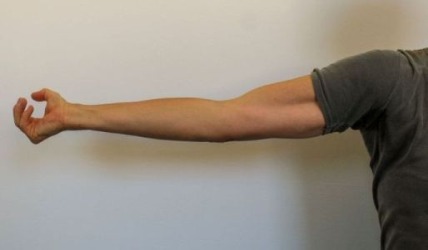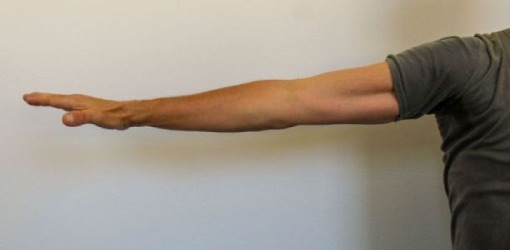yogabook / functional exercises / tense the biceps
Contents
„tense the biceps“

Detailfotos
Tense biceps against triceps | Stretch your elbows, maintain tension | Pronate forearm, hold tension |
Feedback: We’d love to hear what you think about this description, give us feedback at:
postmeister@yogabook.org
last update: 30.12.2018
Trivia name: Tighten biceps
Level: A
- Classification
- Contraindication
- Effects
- Preparation
- Follow-up
- derived asanas
- similar asanas
- Diagnostics
- Instructions
- Details
- Variants
Classification
Classic: Functional posture
Contraindication
Effects
Preparation
No pre-exercises are given for this functional exercise.
Follow-up
derived asanas:
similar asanas:
Diagnostics (No.)
Injuries to the arm flexors, especially the biceps or their tendons, can become noticeable in this posture. A shortening of the biceps in particular will also be noticeable here in the form of a strong pulling sensation in its tendon in the direction of the insertion in the forearm. As the biceps is the supinator of the forearm, this is likely to increase in the final phase, the transition from pronation to supination.
Variants:
Instructions
- Sit comfortably, e.g. cross-legged.
- Extend your right arm to the right at shoulder height.
- Bend your right elbow to 90° and keep your palm facing your head.
- Tense the biceps.
- Slowly stretch your right elbow without losing the tension in your biceps.
- When the elbow is extended, turn the forearm into pronation, i.e. the palm of the hand towards the floor without losing the tension in the biceps.
- When the forearm is maximally pronated, release the tension in the biceps in a flash and build it up again.
- If you can do this safely and reproducibly, slowly take the right arm into the overhead position, i.e. 180° abduction in the shoulder joint, while continuing to alternate between tensing and relaxing the biceps.
- Continue practicing the targeted alternating tensing and releasing of the biceps in this position.
Details
- The purpose of what begins like a bodybuilder’s pose is to gain full control over the biceps in all important postures so that, if necessary, pain in the ulnar elbow gap (at the olecranon) can be neutralized in the event of hyperextension in the elbow under load with the use of the biceps. Quite a few people who are able to hyperextend experience a more or less pronounced unpleasant sensation at the described point. In contrast to sensations such as strain or stretching, this sensation does not indicate a constructive event; rather, it is a sign of unhealthy pressure, which is why we try to avoid it. Whether and at what angle this unpleasant sensation occurs is highly individual. Tensing the biceps without changing the angle in the elbow joint already changes the force ratios there favorably and often causes the discomfort to disappear. The aim of the exercise is to be able to create and maintain any desired angle in the elbow joint, even under load, including the stretched 180° angle desired in many postures.
- The further the arm goes into the overhead movement, the more difficult it is to tense the biceps there or to maintain the tension.
- If the elbow joint is in a position other than fully extended or fully flexed, it is not possible to tense the biceps without simultaneously tensing the triceps to the same extent and at the same time, otherwise this would result in a change in the angle of the elbow joint.
- In the transition from supination of the forearm to its pronation, it is particularly difficult to maintain the tension of the biceps, as the biceps attaches to the radius and therefore wants to pull out of pronation into the middle position between pronation and supination.
- For some people, it is easier to tense the biceps with a closed fist, although this only has a very secondary effect on the elbow joint due to the forearm muscles that attach to the upper arm. Basically, the position of the hand and the tension of the muscles that move the hand and fingers are irrelevant.
- Maintaining the tension in the biceps requires a high level of concentration for people who are not very practiced in this area.
- A similar technique exists for controlling the angle in the knee joint.
